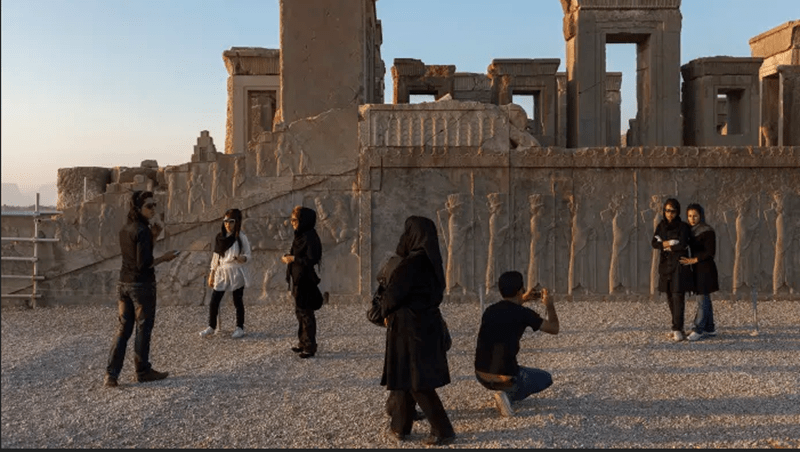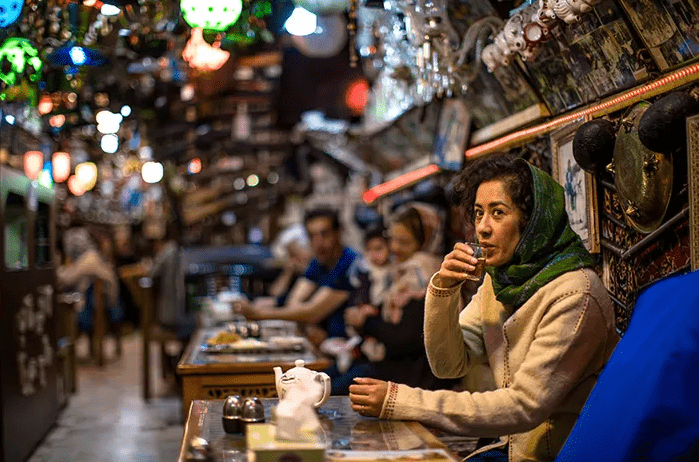It is sunset and I am standing on the top of one of the Towers of Silence — a massive rock citadel where the Zoroastrians once laid out their dead for the vultures, to avoid contaminating the air with cremation, or the earth with burial.
Article by Samira Ahmed | Financial Times

I look down on the desert city of Yazd, in the heart of the Iranian plateau. The adobe-walled settlement glows at dusk, brimming with life. There are hidden cafés down the winding streets, where university students come out at night to share ice- cream sundaes, coffees and mocktails. I’m not the first traveller to fall in love with this place. Some seven centuries ago, Marco Polo walked through the colonnades of its brick-vaulted bazaar, writing admiringly of this “good and noble city”.
From the tower, I can see the landscape of central Iran stretching for miles in every direction. And it hits me — the realisation that the people of this land have been formed for centuries by invasion, the knowledge that hostile armies could come at any time from any direction. As they did. Greeks, Romans, Arabs and Mongols.
For nearly six weeks, between March and June last year, I travelled across Iran to visit a dozen of its 22 Unesco-listed cultural heritage sites, making a three-part series for BBC Arts. We went from the ancient Elamite ziggurat city of Chogha Zanbil in the southwestern desert, to Mashhad in the north-east, where the mausoleum of the 18th-century emperor Nader Shah — the so-called “Napoleon” of Iran — draws Iranians from all over the world to reflect on the apex of the last Persian empire.
There are many ethnic groups beside Persians in modern Iran, among them Azeris, Kurds and Baluchis. But Persia exists as an idea, too. Through exploring its art and culture over 7,000 years, our filming had a mission — to attempt a deeper understanding of modern Iran than can be found in news headlines, by exploring many ordinary Iranians’ cultural identity as Persians. The art of being Persian.
We started filming during Nowruz, the Persian New Year holiday, in March last year. The places we went then were bustling with family groups on day trips to their most famous heritage sites — grandparents introducing children to the wonders of Persepolis, the tomb of Cyrus the Great at Pasargadae, and the sacred Zoroastrian fire temple of Chak Chak, where a spring flows out of a barren mountain like a miracle. Many of these locations were shut for Nowruz this year, as the country struggled to contain the spread of Covid-19.
There was also a Who Do You Think You Are? element to my journey. I was born to Indian parents, and the Persians loomed large in the Amar Chitra Katha comics of history and mythology I read as a child: as bringers of culture, as Parsi religious refugees, but also as looters of the Peacock throne and the Koh-i-noor diamond; the source of everything from the biryani to the language we spoke at home, Urdu; and even the first name my mother very deliberately chose for me. Just as the Romans and Anglo-Saxons lie deep within English identity, I had a sense of connecting with my inner Persian.
Iranians’ sense of their inner Persian is profound. Unlike Saudi Arabia, which has fought a Wahhabist war of purifying annihilation on its own cultural heritage, the flag of Iran’s Islamic Republic flies at every pre-Islamic heritage site. But the regime’s relationship to Persian history is complex.
After the 1979 revolution, there was a mood of purifying zeal. At Persepolis, Islamic revolutionaries turned up with bulldozers. But local people and the mayor of nearby Marv Dasht convinced them to turn back. In 1988, then president Ali Khamenei, now Iran’s supreme leader, visited the site and acknowledged its importance as national heritage, but also declared such places symbols of tyrannical monarchy (it is no coincidence that the Pahlavis, overthrown in 1979, keenly associated themselves with Persia’s historic kings). In recent years, protesters have gathered at Pasargadae, one of the last remnants of Cyrus’s capital city, adopting him as a figurehead of resistance to the regime.
Everywhere we went, we found Iranians delighted to welcome a British film crew exploring their culture. Bold young girls marched up to ask our opinion of their country in careful English. At the tomb of Nader Shah, one Iranian-American, on a family holiday from California, told me he was introducing his US-born children to their Persian roots. Like Nelson to an English schoolboy, Nader Shah had been his own boyhood hero.
In Shiraz, where roses adorn the tiling of the famous Pink Mosque, we focused on the 13th- and 14th-century poets Saadi and Hafez, whose poetry inspired Goethe and the European Romantics. A verse from Saadi adorns the UN Hall of Nations in New York. In Shiraz, both poets have been honoured with elegant garden tombs.
Around the mausoleum garden of Hafez, students flirted discreetly and multigenerational families whispered prayers as they touched the tomb. One woman recited lines of romantic love with exaggerated feeling to amuse her teenage nieces. We tried to capture some of that spirit in the film by getting local people to read verses on camera.
But another literary hero became our guide: Abolqasem Ferdowsi, the 11th-century author of the Shahnameh, the Persian “Book of Kings”, an epic poem that is a magical blending of mythology and real history. I carried Dick Davis’s excellent Penguin translation everywhere we went. Like Shakespeare, Ferdowsi was a boy of humble origins from a small town: Tus in northeastern Iran. But to get a sense of Ferdowsi’s importance to Persian identity, you have to imagine Shakespeare had combined Beowulf and the Arthuriad and the Plantagenets into one chronological national story.
![clip_image047[4] clip_image047[4]](https://parsikhabar.net/wp-content/uploads/clip_image0474_thumb.jpg) The Shahnameh’s 60,000 lines of verse preserved the Persian language against the encroachment of Arabic. Its stories of brave and dastardly kings and queens, and heroic warriors such as Rostam (part Hercules, part Incredible Hulk, part tragic Hector) are deeply embedded in Iranian life. We joined crowds in Isfahan watching actors performing some of the best-loved adventures to the Nowruz crowds.
The Shahnameh’s 60,000 lines of verse preserved the Persian language against the encroachment of Arabic. Its stories of brave and dastardly kings and queens, and heroic warriors such as Rostam (part Hercules, part Incredible Hulk, part tragic Hector) are deeply embedded in Iranian life. We joined crowds in Isfahan watching actors performing some of the best-loved adventures to the Nowruz crowds.
It is strange to realise that Ferdowsi travelled far and wide in Persian lands, unable to read the cuneiform inscriptions on the tombs of these ancient kings; guessing at the history of the monuments of once-mighty civilisations and creating new stories to fill the ellipses; stories that took on a life of their own and remain intertwined with Iranians’ sense of themselves.
I had the luxury, from time to time, of wandering alone around these magnificent ruins. Occasionally when I was far from the camera and my production team, people would approach me carefully and pour out their frustrations with the regime; some claimed that the Islamic Republic’s hard core does not cherish or care for these places as ordinary Iranians do.

I got to see a country that despite — or perhaps because of — years of crippling sanctions, does things its own way, without the crass and oppressive extremes of western consumer capitalism, which has been so eagerly embraced in India since the early 2000s. We drove through orchards of peaches and nectarines, past lush paddy fields near the Caspian Sea, and stopped at roadside stalls every day as the melon harvest hit the streets.
It took nearly three years from our first application to secure our visas to travel. In that time Donald Trump’s election, the jailing of the dual British-Iranian citizen Nazanin Zaghari-Ratcliffe and Tehran’s unrelenting hostility to the BBC’s Farsi-language Persian Service had all raised tensions.
The irony was certainly not lost on us that when Iranian forces shot down a US military surveillance drone in June 2019, sparking a war of words and threats with Washington, our cameraman Craig Hastings was filming sweeping shots with his drone camera across the Gorgan Wall, a 200km-long brick barrier built by the Sassanians a hundred years before the Great Wall of China, watched approvingly by local officials.
Al![clip_image053[4] clip_image053[4]](https://parsikhabar.net/wp-content/uploads/clip_image0534_thumb.jpg) lowing us in with such generous access seemed an important olive branch. And a wider cultural exchange could have economic benefits too, especially for a government struggling under sanctions. In bazaars, palaces and mosques, we crossed paths with tour groups from Europe, Japan and China. Coach loads of them arrived with their selfie-sticks like clockwork every morning for the moment when the sun hits the kaleidoscopic stained-glass windows of the Pink Mosque in Shiraz.
lowing us in with such generous access seemed an important olive branch. And a wider cultural exchange could have economic benefits too, especially for a government struggling under sanctions. In bazaars, palaces and mosques, we crossed paths with tour groups from Europe, Japan and China. Coach loads of them arrived with their selfie-sticks like clockwork every morning for the moment when the sun hits the kaleidoscopic stained-glass windows of the Pink Mosque in Shiraz.
What did our journey achieve? Part cultural diplomacy, for sure. Towards the end of our time in Tehran, the culture ministry brought out one of their rarest manuscripts from the Golestan Palace archives for us to film; a Timurid-era Shahnameh — an exquisite illuminated version. It was a moving moment, for officials, for the BBC team and for Giti Norouzian, the Iranian scholar turning the pages by my side, who had never seen it before.
There is a hope that the culture ministry might open up access to such treasures more generally to academics. Professor Lloyd Llewellyn Jones, a Persian expert from Cardiff University, says the gesture is “miraculous”. “Scholars wait lifetimes to see such manuscripts,” he says. “There is this increasing awareness that Iran wants to be part of the wider academic world as well. I hope it bodes well for the future.”
At heart, thinks Llewellyn Jones, rapprochement is simply about respect; western governments appreciating the global legacy of Persian culture — from the qanats or water channels that irrigated the earliest cities on Earth, to the poets who inspired the European Romantics, to the Persian male fitness tradition, which inspired the club-wielding callisthenics of the Victorian gentleman’s gymnasium.
Lockdown has led many of us in the west to seek out a deeper and more nuanced understanding of our place in the world. Looking beneath the news headlines about the Iranian regime offers the chance to make a connection with the Iranian people and gain a new perspective on the world. One that is less western-centric. In the Chogan river gorge near Bishapur, I stood beneath a relief of Shapur I, showing him triumphant over three Roman emperors — Gordian III, Philip the Arab and Valerian — and felt my horizons had changed forever.
‘Art of Persia’, presented by Samira Ahmed, starts on BBC Four on Monday June 15 at 9pm

![clip_image013[4] clip_image013[4]](https://parsikhabar.net/wp-content/uploads/clip_image0134_thumb.jpg)
Thank you Samira Ahmed for taking me along on this beautiful journey. Lovely writing, emotions, and imaginations.